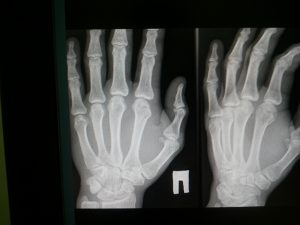Safety Checklist for Digital Radiography

Safety checklists aid radiologic technologists and prevent them from skipping important stepsThere are certain critical steps in digital radiography which, if omitted, can cause potential harm to patients and staff. A safety checklist for digital radiography is therefore important, especially in light of the fact that this technology is the most commonly used imaging modality in America at the current time. Digital radiography represents approximately three-fourths of all radiologic examinations in adults and children. In 2006, an NCRP report estimated that there are nearly 325 million general radiographic examinations conducted each year. A safety checklist for digital imaging technologies reinforces radiation protection practices. It assists medical professionals in performing digital radiography according to best practices.
A safety checklist for digital radiography has been shown to reduce errors and improve safety. Checklists provide a standardized approach and remind the radiographer of the vital steps that must be performed to minimize errors. Some of the steps that the radiologic technologist must perform before, during, and after obtaining a digital radiographic image are listed below.
Before Starting the Examination
- Select the patient’s name from the worklist
- Verify the patient’s identity
- Check the appropriateness criteria for the requested examination
- Explain the examination to the patient
- Verify the pregnancy status in female patients of childbearing age
During the Examination
- Check alignment of the primary beam, anatomy of interest, and image receptor
- Check the source-to-image distance (SID)
- Determine whether a grid is required
- Position the patient correctly
- Collimate the beam
- Select the appropriate technical factors
- Place markers and appropriate shielding (for example, use gonadal shielding in patients with procreative potential if the gonads are within 2 inches of the radiation field, unless the shield interferes with obtaining the necessary information from the examination)
- Adjust tube and settings
- Give the patient instructions regarding breathing, holding still, etc.
Safety Checklist for Digital Radiography – After the Examination
- Review the displayed images and confirm the patient’s identification
- Review the image quality
- Check that the exposure index is within target range
- Reprocess or repeat image if necessary
- Perform post-processing only if required
- Verify exam and report and archive to PACS
Pause Points
It is a good idea for radiographers to identify pause points in their normal workflow. At these pause points, they should confirm and complete the above-mentioned safety checklist items. The pause points should be such that omission of any action prior to this time does not harm the patient. The safety checklist actions mentioned above are discussed in further detail below.
Patient Identification
Selecting the correct patient name from the worklist is critical to ensure that the correct examination is performed on the correct patient. This is a critical component of the safety checklist for digital radiography. According to HIPAA guidelines, the patient’s identity should be confirmed with at least two identifiers, such as name, medical record number, date of birth, etc. Sometimes an anxious patient may inadvertently respond to the wrong name when called to the procedure room. Verification with two identifiers is necessary to ensure that a patient does not undergo an inappropriate examination.
Appropriateness of the Examination
Checking the appropriateness criteria for the requested examination involves questioning the patient about their medical history and checking the side (left versus right) when appropriate. When the radiographer explains the examination to the patient, he or she gives instructions regarding immobilization, positioning, breathing, and shielding. This dialogue assures the patient’s cooperation and reduces the probability of a repeat exposure due to movement artifact.
Another point on the safety checklist for digital radiography is pregnancy status. Before performing a radiographic examination, the radiographer must question all female patients of childbearing age (12 to 55 years old) about the possibility of pregnancy. Additional questions may be necessary to clarify the patient’s pregnancy status. If pregnancy is possible, the radiologic technologist should consult with the radiologist and referring physician about the need to perform a confirmatory pregnancy test and non-radiating alternatives.
Equipment Selection and Image Acquisition
Anti-Scatter Grids
The use of an anti-scatter grid for parts of the body that are more than 10 cm thick results in reduced scatter on the image receptor and a diagnostic quality image. This is of importance while imaging obese patients, for example. However, using a grid on body parts less than 10 cm thick (for example, in pediatric patients) can result in unnecessary radiation dose. Measurement of thickness with calipers is the most accurate way of determining the correct technique, i.e., with or without grid. This must be part of the safety checklist for digital radiography.
Tube Angle and SID
Selecting the appropriate tube angle and SID, centering the beam on the image receptor, and collimating the beam are all essential steps in radiation safety. Checking the alignment of the primary beam, anatomy of interest, and image receptor during image acquisition ensures that all essential anatomy is included in the image and no unnecessary tissue is irradiated.
Patient Positioning
Positioning and immobilizing the patient correctly is another point on the safety checklist for digital radiography. This is necessary to assure that a repeat exposure will not be needed due to motion artifact. Breathing instructions to the patient are necessary to reduce blurring and the need for repeat imaging.
Collimation
Collimating the beam to the smallest field size that includes all essential anatomy reduces the amount of tissue irradiated and decreases scatter. The patient’s size and the body part being imaged determine the appropriate exposure factors, i.e., the kVp required for optimal penetration of the body part. A high kVp and low mAs technique is associated with a lower patient exposure to radiation. The selection of exposure factors is thus a critical action in the safety checklist for digital radiography.

Shielding and Lead Markers
Also, during the procedure, the placement of shielding (to protect the gonads, for example) is essential for radiation protection, provided the shielding does not interfere with obtaining the required diagnostic information. The placement of lead markers assures that the correct body part is imaged and treated. Lead markers are also important for legal documentation. Before the X-ray exposure is made, the radiographer makes one final check on patient placement and tube alignment.
Image Review

After the examination, review of displayed images is essential to make sure electronic collimation matches the physical collimation used during the exam. This point in the safety checklist for digital radiography is performed to ensure that electronic collimation does not clean up the image and obscure needlessly irradiated areas.
The patient’s identification is once again confirmed to assure the information is archived to the appropriate record. Reviewing the image quality is necessary to ensure all essential anatomy has been imaged, no artifacts are present, and appropriate lead markers are included in the image.
Other Factors
Checking that the exposure index is within the target range is a necessary radiation safety measure to ensure there is no underexposure (which manifests as noise) or overexposure (which manifests as oversaturation or graying of anatomical structures). If the image is exposed outside the acceptable range, repeat imaging may be needed in consultation with the radiologist. If image processing errors result in an image that is not of diagnostic quality, alternative procedures should be given consideration. Repeat imaging should be the last resort as it entails additional radiation exposure to the patient. However, if inadequate exposure or positioning is detected during image quality review, the procedure may be repeated with corrective actions. These factors make image review an important component of the safety checklist for digital radiography.
Excessive post-processing by the radiographer, for example, adjusting the window width and level, is not recommended as it does not allow the radiologist to fully manipulate the image during interpretation. Some information may be lost if excessive post-processing is performed. For example, a small low-contrast object may be blurred out when a noise reduction filter is applied to the image. Finally, the radiologic technologist sends the image to PACS for reporting and archiving.
X-ray Continuing Education
We offer a variety of online X-ray CE courses on our website with category A credits that will complete your ARRT® CE requirements. In addition to the ARRT®, our courses are accepted by NMTCB, ARDMS, SDMS, every US state and territory, Canadian province, and all other Radiologic Technologist, Nuclear Medicine, and Ultrasound Technologist registries in North America for both full and limited permit technologists, guaranteed. You have the freedom to choose a course with the number and type of credits you need.
Not sure about system requirements? Wondering how the online X-ray CE process works? Visit our FAQs page. Still got questions? Contact us with your queries.